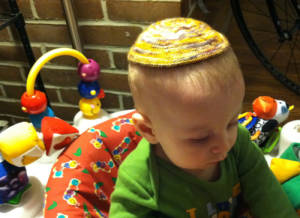
By Rabbi Ari Enkin, rabbinic director, United with Israel
Our sages teach us that clothing is not merely a protection against cold or for ornamentation. Clothing constitutes the primary and necessary distinguishing mark of human society.
The tallit is the Jewish prayer shawl worn by men during morning prayers. On the corners of the tallit are tzitzit (fringes or tassels).There are two customs as to when one should begin wearing a tallit. In some communities it is worn from the Bar Mitzvah onwards, while in others it is only worn after marriage. All orthodox males wear a tallit katan (four-cornered garment with fringes) under their clothing.
Most tallits have black or blue stripes as part of their design. These are not mandatory, and in fact, in some communities only white tallits are used. But the reason for them is to remind us of the techelet, the blue thread that used to be included in the tzitzit strings. (Actually, there is a movement nowadays to re-introduce the biblical blue thread!) Furthermore, according to Kabbalah (Jewish mysticism), the color white represents God’s kindness, while the color black represents his strictness. Therefore, the tallit is essentially a white garment with a small amount of black to symbolize our hope that God’s kindness should overtake over His strictness.
Kippot, Jewish skull caps, can be seen on the heads of orthodox Jewish men all over. This is probably the most obvious sign to recognize and spot an orthodox Jew. A kippah is also called a yarmulke. You most probably wonder why orthodox Jews wear a kippah. Is there any biblical commandment to wear a yarmulke? When did this custom start?

A child’s first kippah. (pullingatstrings.com)
It begins in the Talmud, which states, “cover your head, so you should fear from Heaven.” It also says in the Talmud that there were sages who would not walk eight feet without their heads covered. It is explained that covering one’s head shows respect to God who is symbolically “above us.” Some attribute the wearing of a kippah to a need or desire to differentiate ourselves from Christians, for whom a bare head was a sign of respect. By the 16th century, wearing a kippa had become so common that it was codified as law. Hence, it is a custom that has developed into a requirement. It is customary that a boy start wearing a yarmulke by age three.
Very often one can judge a man’s religious and political affiliation by the type of kippah that he wears. For example, haredi (ultra-orthodox) Jews wear a yarmulke of black velvet that covers most of the head. Modern orthodox Jews mostly wear smaller suede or colorful crocheted yarmulkes. Jerusalemites and Breslov Hasidim wear white crocheted yarmulkes, and religious Zionists wear color crocheted yarmulkes.
The shtreimel is the fur hat worn by most married hasidic men on the Sabbath, Jewish holidays, and festive occasions. The most widely seen shtreimel is typically worn by the hasidim of Galicia, Romania, and Hungary, and was worn by Lithuanian Jews up until the 20th century. It comprises a large circular piece of black velvet surrounded by fur. Some hasidim of Polish descent wear a high shtreimel (often called a spodik). A shtreimel is typically custom-made of genuine fur for the intended wearer. It is also the most costly article of hasidic clothing, ranging in price from US$1,000 to US$5,400. It is possible to buy a shtreimel made of synthetic fur, which is cheaper and more common in Israel.

Hasidim wearing shtreimels, the traditional fur head covering worn by married men on the Sabbath and festivals. (tallit-shop.com)
The bekeshe is a long coat worn by hasidic Jews, usually made of black silk or polyester. It is generally worn only on Shabbat, holidays or other special occasions. On weekdays they wear a rekel, a long coat, or suit-like jacket, made of wool or polyester. Hasidic rabbis who wear a bekishe during the week wear a more ornate version on the Sabbath, often lined with velvet or some color other than or in addition to black.
Whatever you wear, you should be sure that your clothes are in good taste and reflect what you want others to think of you. As Rabbi Yochanan said, “my garments are my honor.” Furthermore, the Talmud says that it is a disgrace for a scholar to go out into the marketplace with patched shoes, and that any scholar who has a grease stain on a garment is worthy of death.
It is our clothes that distinguish us from the animal world. Indeed, our sages teach us that clothing is not merely a protection against cold or for ornamentation. Clothing constitutes the primary and necessary distinguishing mark of human society. It serves to set man higher than the beast. The status of a man is reflected in the character of his attire. Whatever clothing you wear: always make sure that it is dignified and that you look your best.

